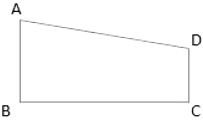Quadrilaterals Class 9 Worksheet Maths Chapter 8
True or False
Which are these is true or false about parallelogram
Q1: The diagonals of a parallelogram bisect each other.
Q2: In a parallelogram, opposite sides and angle are equal.
Q3: A diagonal of a parallelogram divides it into two congruent triangles.
Q4: The bisectors of the angles of parallelogram create a rectangle.
Q5: Sum of all the internal angles is 3600.
Q6: Sum of all the exterior angles is 1800.
Q7: Square, rectangle and rhombus are all parallelogram.
Q8: Consecutive angles are supplementary.
Multiple Choice Questions
Q1: ABCD is a parallelogram and AP and CQ are perpendiculars from vertices A and C on diagonal BD Which of the following is true based on given information
Which of the following is true based on given information
(a) AP = CQ
(b) QD = PB
(c) DP = QB
(d) ΔPAD ≅ ΔQCB
Q2: The angles of the quadrilateral are in the ratio 2 : 5 : 4 : 1? Which of the following is true?
(a) Largest angle in the quadrilateral is 150º
(b) Smallest angle is 30º
(c) The second largest angle in the quadrilateral is 80º
(d) None of these
Q3: Two adjacent angles in a parallelogram are in the ratio 2 : 4. Find the values?
(a) 80, 100
(b) 40, 140
(c) 60, 120
(d) None of the above
Q4: ABCD is a trapezium with AB = 10cm, AD = 5 cm, BC = 4 cm and DC = 7 cm? Find the area of the ABCD
Find the area of the ABCD
(a) 34 cm2
(b) 28cm2
(c) 20 cm2
(d) None of these
Q5: ABCD is a trapezium where AB||DC. BD is the diagonal and E is the mid point of AD. A line is draw from point E parallel to AB intersecting BC at F. Which of these is true? (a) BF = FC
(a) BF = FC
(b) EA = FB
(c) CF = DE
(d) None of these
Answer the following Questions
Q1: Show that the quadrilateral formed by joining the mid-points of adjacent sides of rectangle is a rhombus.
Q2: P, Q, R and S are respectively the mid- point of sides AB, BC, CD and DA of a quadrilateral ABCD such that AC = BD. Prove that PQRS is a rhombus.
Q3: l, m and n are three parallel lines intersected by transversal's p and q such that l, m and n cut off equal intercepts AB and BC on p. Show that l, m and n cut off equal intercepts DE and EF on q also.
The solutions of the worksheet "Worksheet Solutions: Quadrilaterals"
|
44 videos|412 docs|54 tests
|
FAQs on Quadrilaterals Class 9 Worksheet Maths Chapter 8
| 1. What are the different types of quadrilaterals? |  |
| 2. How can we determine if a quadrilateral is a square? |  |
| 3. What are the properties of a rectangle? |  |
| 4. How do we identify a parallelogram? |  |
| 5. What is the difference between a rhombus and a square? |  |

|
Explore Courses for Class 9 exam
|

|


















